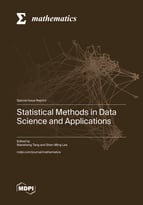Statistical Methods in Data Science and Applications
A special issue of Mathematics (ISSN 2227-7390). This special issue belongs to the section "Probability and Statistics".
Deadline for manuscript submissions: closed (30 November 2023) | Viewed by 22502
Special Issue Editors
Interests: Bayesian statistics; empirical likelihood; nonparametric inference; high-dimensional data analysis; longitudinal data analysis; quantile regression; structural equation models
Special Issues, Collections and Topics in MDPI journals
Special Issue Information
Dear Colleagues,
With the development of big data, the importance of data science is growing rapidly, leading to a large number of studies in various disciplines. such as mathematics, statistics, computer science, and artificial intelligence. Data science requires modeling, computation, and learning to realize conversion from data to information, from information to knowledge, and from knowledge to decision making. Due to the complexity of big data, such as missing, high- and ultrahigh-dimensional, response-dependent, time series, distributed storage, etc., the existing big data analysis theories, methods, and algorithms are facing huge challenges, particularly in terms of basic statistical theories, methods, and algorithms around estimation, hypothesis testing, confidence interval, and variable selection, including frequentist and Bayesian big data.
Prof. Dr. Niansheng Tang
Prof. Dr. Shen-Ming Lee
Guest Editors
Manuscript Submission Information
Manuscripts should be submitted online at www.mdpi.com by registering and logging in to this website. Once you are registered, click here to go to the submission form. Manuscripts can be submitted until the deadline. All submissions that pass pre-check are peer-reviewed. Accepted papers will be published continuously in the journal (as soon as accepted) and will be listed together on the special issue website. Research articles, review articles as well as short communications are invited. For planned papers, a title and short abstract (about 100 words) can be sent to the Editorial Office for announcement on this website.
Submitted manuscripts should not have been published previously, nor be under consideration for publication elsewhere (except conference proceedings papers). All manuscripts are thoroughly refereed through a single-blind peer-review process. A guide for authors and other relevant information for submission of manuscripts is available on the Instructions for Authors page. Mathematics is an international peer-reviewed open access semimonthly journal published by MDPI.
Please visit the Instructions for Authors page before submitting a manuscript. The Article Processing Charge (APC) for publication in this open access journal is 2600 CHF (Swiss Francs). Submitted papers should be well formatted and use good English. Authors may use MDPI's English editing service prior to publication or during author revisions.
Keywords
- big data
- missing data
- high-dimensional data
- ultrahigh-dimensional data
- response-dependent data
- survival data
- longitudinal data
- censored data
- time series data
- machine learning
- meta learning
- deep learning
- online learning
- reinforcement learning
- knowledge graph
- distributed inference
- Bayesian inference
- variational Bayesian learning
- supervised learning
- semi-supervised learning
- resampling-based inference
- estimation
- variable selection
- hypothesis test
- confidence interval
- computation
- optimization algorithm
- data clustering
- data classification
- data mining







